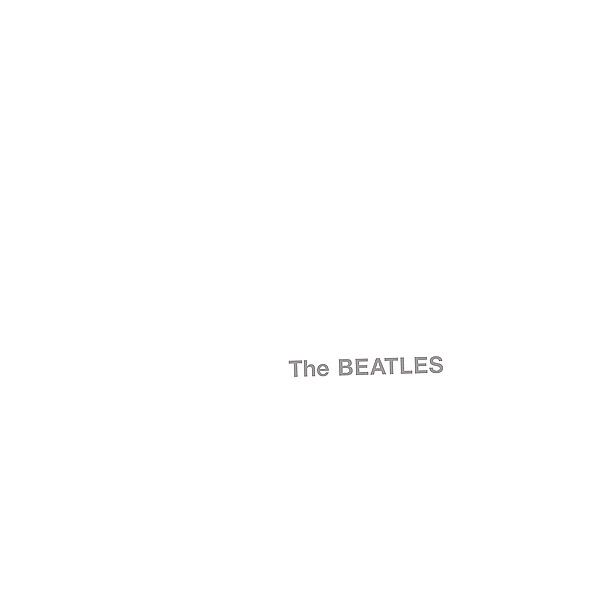
September - October 1968
Designing the packaging for the White Album
Last updated on November 20, 2024

September - October 1968
Last updated on November 20, 2024
Previous article Aug 30, 1968 • Paul McCartney attends Neil Aspinall's wedding
Single Aug 30, 1968 • "Sour Milk Sea / The Eagle Laughs at You" by Jackie Lomax released in the UK
Single Aug 31, 1968 • "Thingumybob / Yellow Submarine" by Black Dyke Mills Band released in the UK
Article September - October 1968 • Designing the packaging for the White Album
Article Early September 1968 • Paul McCartney on holiday in Sardinia
Session September 1968 ? • Recording "Those Were The Days" in other languages
By The Beatles • LP
By The Beatles • LP
Richard Hamilton also conceived the idea of a photographic montage to be included as a large, free poster insert, which reverse side featured the album’s song lyrics.
Hamilton requested personal photos from the four Beatles, and Paul collaborated with him on assembling the photos for the montage. As part of his selection, Paul McCartney contributed recent photos taken by photographer Linda Eastman, his new girlfriend. One photo depicted him naked, exiting a bathtub, with his intimacy obscured only by a white pole, garnering significant press attention (he was the second Beatle to appear nude, following John Lennon’s contentious cover for “Unreleased Music Vol. 1“, which was released just ten days prior to the White Album). The Beatles’ press officer, Derek Taylor, bemoaned at the time, “All this work, all this talent — and what [the press] fixate on is one small picture.”
In 2018, a new promotional film for the song “Glass Onion” was released to commemorate the 50th anniversary of the White Album, illustrating the creative process behind the poster.
[The white cover] was agreed, but then I began to feel a bit guilty at putting their double album under plain wrappers; even the lettering is casual, almost invisible, a blind stamping. I suggested it could be jazzed up with a large edition print, an insert that would be even more glamorous than a normal sleeve.
Robert Hamilton – From “Blinds & Shutters – The Story of the Sixties” by Michael Cooper
The double white album cover had been put together by a conglomerate. Neil and Mal had collected all the old Beatle snapshots that were to make up the collage poster to be included inside, Jeremy was to act as chief coordinator and got John Kelly to take the four beautiful portraits, a designer named Gordon House had put the finished mechanical together. The minimal concept had been talked over by all four Beatles with Neil, Mal, Derek, and Apple Records.
From “The Longest Cocktail Party: An Insider Account of The Beatles & the Wild Rise and Fall of Their Multi-Million Dollar Apple Empire” by Richard DiLello, 2014
Robert Fraser, my swinging art dealer, was friendly not only with Mick Jagger and the Stones but also with the Beatles. He encouraged several of his artists to undertake commissions to make record sleeve designs and got the groups involved with the artists. Paul McCartney was taking a very active role in putting together the double album called The Beatles’ and I took responsibility for the design of the package with Gordon House looking after the printing and Paul McCartney working with me a good deal of the time in the studio. Inside the album was a give-away ‘print.’ Most of the design effort and expense went into this. Because the sheet was folded three times to bring it to the square shape for insertion into the album, the composition was interestingly complicated by the need to consider it as a series of subsidiary compositions.
Richard Hamilton – From “Richard Hamilton“, 1973
[Richard Hamilton] said ‘Have you got any old photos of the Beatles? They must all have family photos from when they were young, or any nice photos. Get me a lot of source material.’ So I acted as the middleman. I went to the guys and said, ‘Childhood photos, what have you got? Look in your cupboards. New photos if you want. Whatever you like,’ and they brought in stuff from the bottom drawer that their mums had kept, along with their old rent books, all the old baby pictures. I told him, ‘My wife’s a photographer. She’s got some pretty cool stuff. Would you like to look at that?’ He said, ‘Yes,’ so I took that out to him as well.
Paul McCartney – From “Paul McCartney: Many Years from Now” by Barry Miles, 1997
Inside the sleeve they wanted to put a poster which would have the lyrics printed on it. Paul and Richard had decided to get all of us to put their pictures in a box and they would choose a selection to put on the poster. I put in some I had taken of Paul in the bath and they were used.
Linda McCartney – From “Linda McCartney’s Sixties“, 1992
I used to go out to [Richard Hamilton’s] house in Highgate and chat about it, and one day he said: ’OK. Get lots of snapshots: go back to all your baby photos, get photos of yourselves – any kind – and I’ll make a collage.’ It was very exciting for me because I’m into art, and I could be his assistant for the week – liaising between the guys; getting the photographs and having them copied. Then I just sat round for the week watching him put the collage together. It’s lovely just watching someone paint. The great thing at the end of it was that when he’d filled the whole collage with photos, his final move was to take pieces of white paper and place them strategically to give space through the whole thing, so that it wasn’t just crammed with pictures. He explained that this was so the whole picture could breathe. You could see through the density, which was a great idea and gave me my education about negative space (which apparently is what it was called). I think I would have just left it as it was, because it looked great anyway; but if you look at that poster now, the white areas are very clever.
Paul McCartney – From “The Beatles Anthology” book, 2000
Richard and I worked together on the collage for The Beatles’ White Album. Richard and I sat down all week while he did the collage from childhood photos of us all. The thing that impressed me at the end of the week was that after he’d filled the whole board with pictures and got his composition right, his final move was to take pieces of white paper and place them strategically to give space through the whole thing so that it wasn’t just crammed with pictures. It was beautiful and I remember being very impressed with the way he put this negative space on – it was the first time that I’d ever seen that idea.
Paul McCartney – From “The Beatles Diary Volume 1: The Beatles Years” by Barry Miles
Every day for two weeks Paul drove out to Richard’s house and they worked together on ideas. Richard was well into white at that time. I remember Paul telling me that Richard would put pictures up and then he would paste white paper over some areas so as to create even more white space.
Linda McCartney – From “Linda McCartney’s Sixties“, 1992


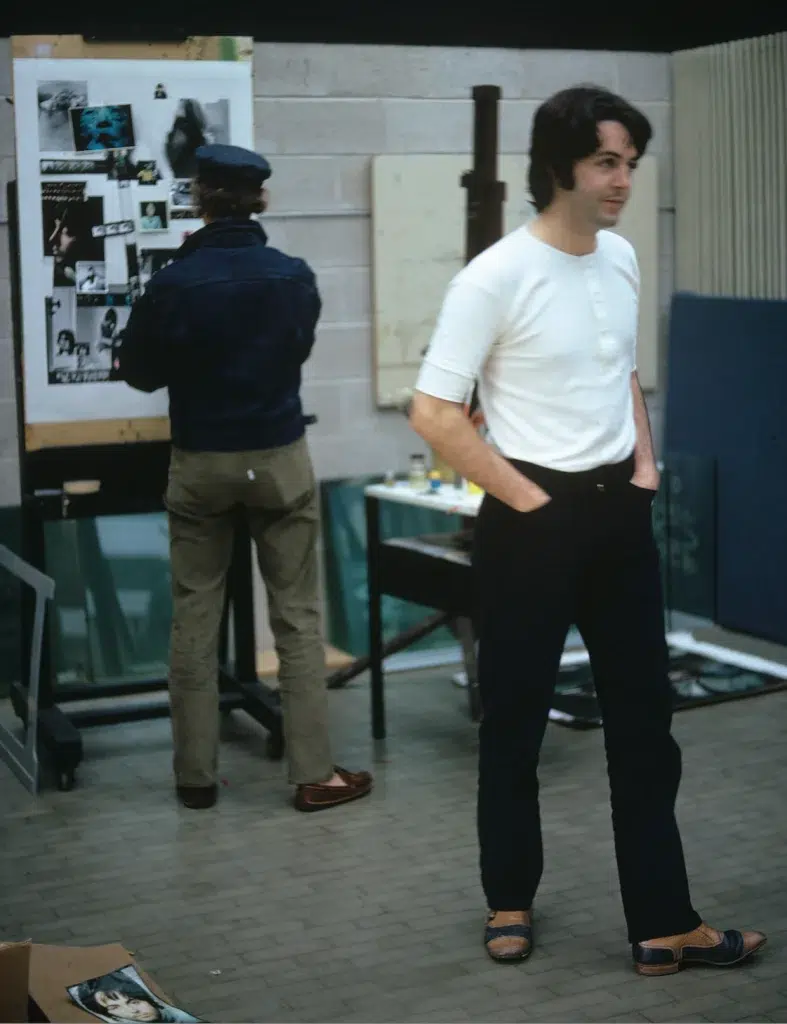
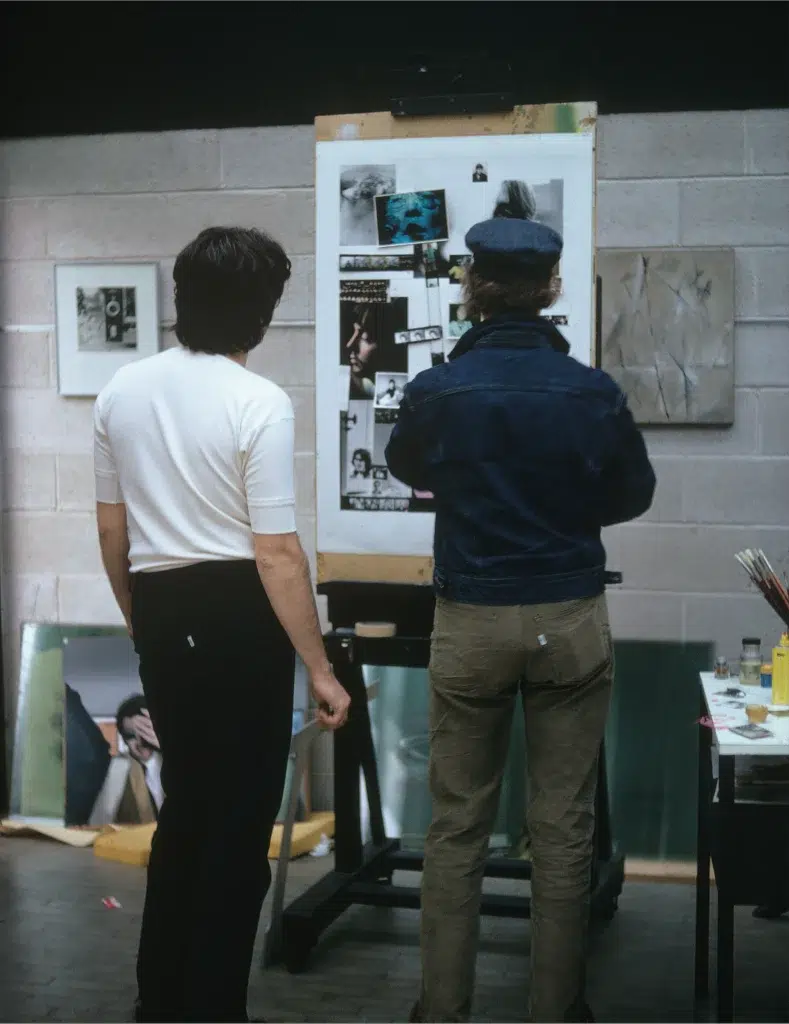

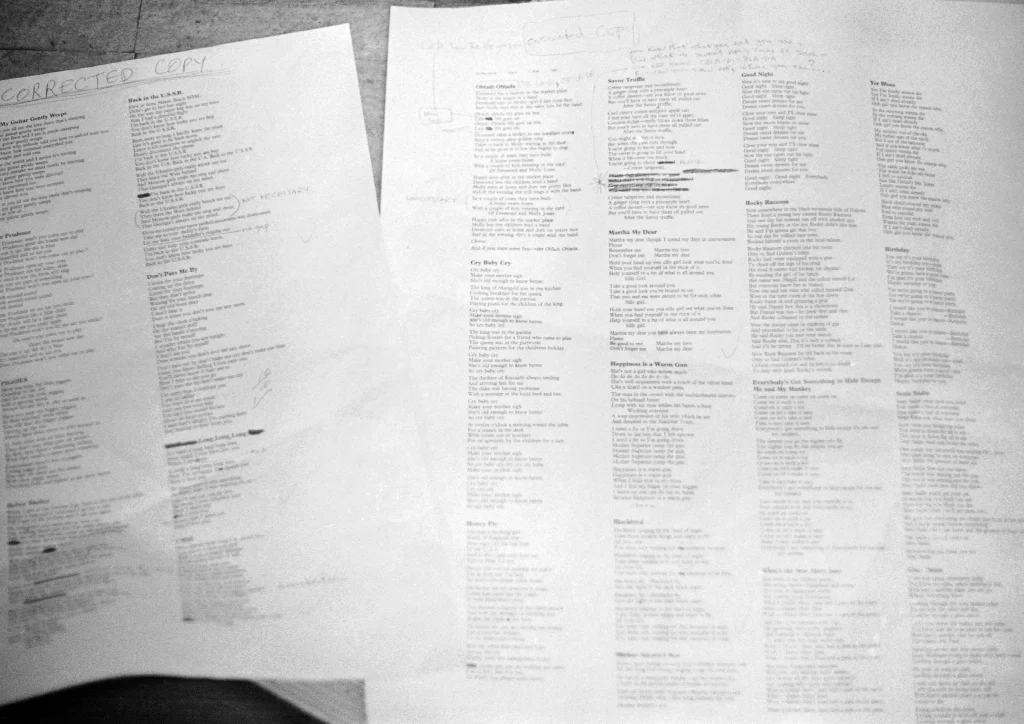
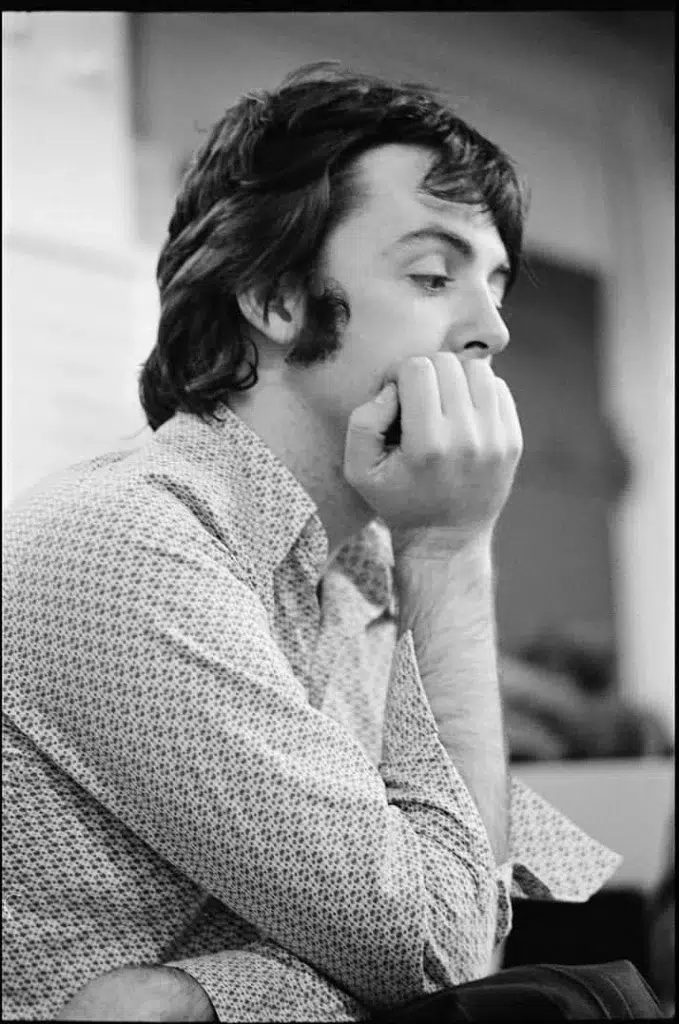
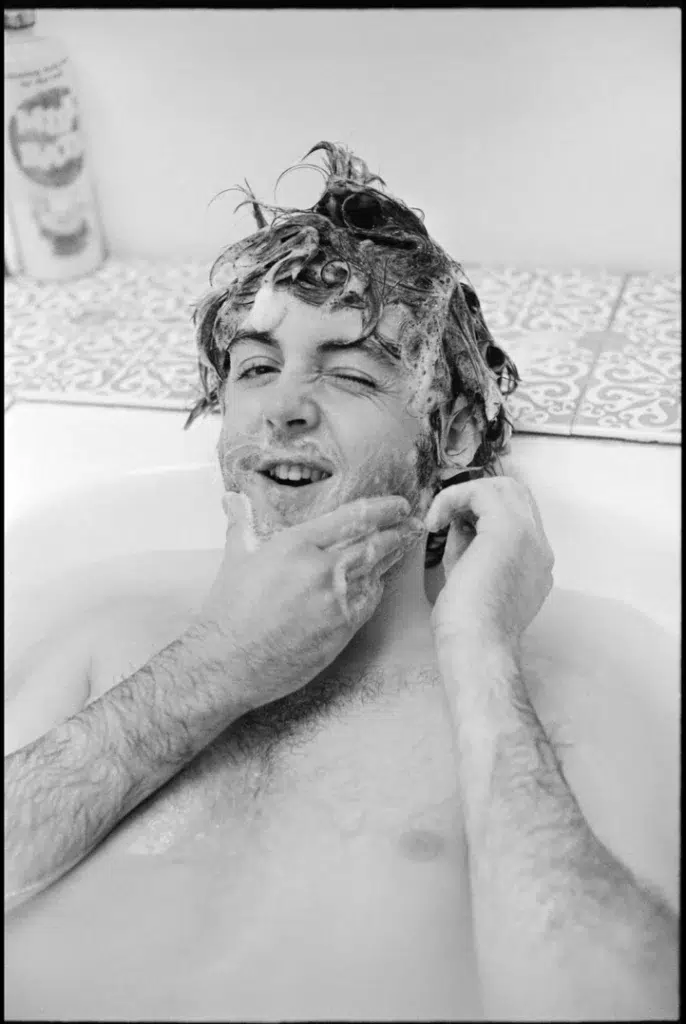
NOW IT’S BEATLE PAUL IN NUDE
Nudity — apparently the latest fashion among pop people — has spread to Paul McCartney. On a special montage included with the Beatles’ new long playing record is a small snapshot showing McCartney nude in his bathroom.
He appears to be standing behind a very narrow pillar. “You can’t really see anything,” explained Paul. “I don’t really think the picture is offensive.“
Also in the montage is a picture of John Lennon sitting naked answering the telephone while his girl friend Yoko Ono is seen in bed alongside him, and a sketch drawn by Lennon of the two of them in the nude.
The photograph of Lennon is, however, considerably less revealing than the one he and Yoko chose for the cover of their experimental Two Virgins album. Because of the nature of the photograph on the cover of that record both EMI (in Britain) and Capitol (in America) refused to distribute it. But a small company, Tetragrammaton Records, have now agreed to issue the disc in America so long as it is sold inside brown paper bags.
British distributors have not yet been named for the Two Virgins record. The Beatles’ new album will be released by Apple Records next week.
A friend of the Beatles said today: “They started the year off with the Maharishi. It looks as though they’ll close it with Harrison Marks.”
From Evening Standard – November 13, 1968

The production of the packaging presented technical challenges, particularly with the embossing of “THE BEATLES” and the unique numbering of each album. Only the first two million copies of the LP featured an individual edition number. However, since the numbering system was identical across all pressing plants, multiple discs shared the same number.
Gordon House also experienced EMI’s initial reluctance to number the album and refusal to provide the thicker than usual card stock that was needed to manufacture the album cover:
“At the EMI production meeting, the EMI sales manager, marketing team and the all-important print buyer, I put forward the request for thicker white board and for each album to be individually numbered as a multiple work. After a heated discussion, with a terminating “no way”, I scuttled back to report to Paul at Apple … McCartney, now angry at the rebuff just said, “Right, fuck them. Leave it to me.””
After making a series of phone calls, Paul sent a telegram to the chairman of EMI. The next day, Gordon House was amazed to find the same EMI executives, ‘who had now obviously been re-briefed from above’, now asking what was wanted.
‘The power of The Beatles ruled!’
From “The Beatles” Super Deluxe book, 2018
The [title] on the album cover was embossed. It was therefore somehow raising the surface of the album cover. The printer said that they could not get a hundred albums, which is the normal standard packing, in a package to send to people. It could only keep 98 or 99. So there was discussion going on to keep or drop the plan of embossing… It all went through at long last, but it proved to be a bit of a struggle.
John Kelly – Photographer – From Beatles Unlimited fanzine #99 November/December 1991
Then he had the idea to number each album, which I thought was brilliant for collectors. You’d have 000001, 000002, 000003, and so on. If you got, for example, 000200 then that would be an early copy – it was a great idea for sales. EMI weren’t easy to persuade and they said they couldn’t do it. I said: ‘Look, if a milometer can turn over, you must be able to do that with every record that goes out.’ And they found a way. I think they stopped at some point, so not all ‘White’ albums have the numbers on them. But it was a good idea and we got the first four. John, I think, got the first one. He shouted loudest!
Paul McCartney – From “The Beatles Anthology” book, 2000
In 1967, Peter Blake and Jann Howarth received £200 for their work on the “Sgt. Pepper’s Lonely Hearts Club Band” cover. Similarly, Richard Hamilton was compensated with approximately the same amount for his contribution to the White Album, remarking, “I thought that was a bit mean. I was surprised at how little we received.“
The Beatles Diary Volume 1: The Beatles Years
"With greatly expanded text, this is the most revealing and frank personal 30-year chronicle of the group ever written. Insider Barry Miles covers the Beatles story from childhood to the break-up of the group."
We owe a lot to Barry Miles for the creation of those pages, but you really have to buy this book to get all the details - a day to day chronology of what happened to the four Beatles during the Beatles years!
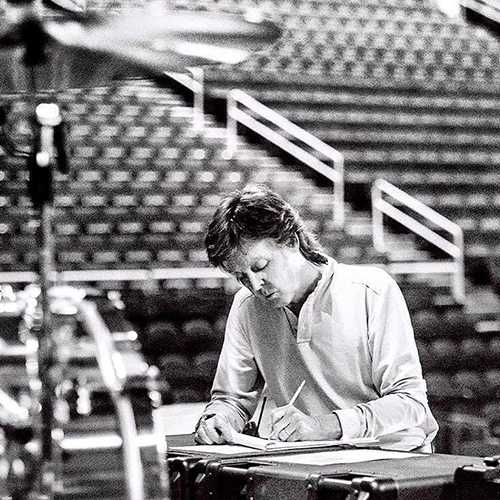
Notice any inaccuracies on this page? Have additional insights or ideas for new content? Or just want to share your thoughts? We value your feedback! Please use the form below to get in touch with us.